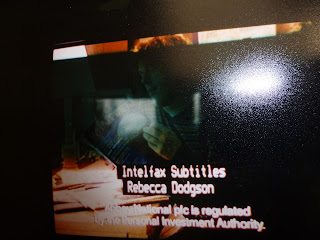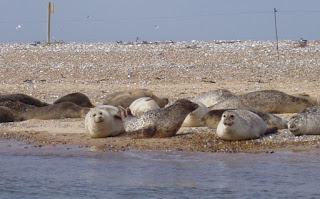 |
| Pioneer Square, somewhere near Cafe Nervosa |
"Go ahead, caller. I'm listening."
I love Frasier, and it was with great sadness that I learned of the death of John Mahoney this week, at the age of 77. Which - if nothing else - means that Martin Crane must have been pretty young when Frasier and Niles were born.
My husband and I have been known to watch Frasier box sets on a continuous loop, though it's been a while (post-child) since we found the time. Nonetheless we've seen each episode so many times that you'd think we'd know the scripts by heart, but actually the language is so nuanced that it's difficult to quote it precisely. I think you don't appreciate just how rich the vocabulary is until you see it written down.
Which I used to do for a living. It was always the greatest day of my working life when I was given an episode of Frasier to subtitle for broadcast on Channel 4. It made all those Countdowns and 15 to 1s and Jobfinders and Ready Steady Cooks and late-night motor racing and porn-in-all-but-name shows worthwhile. Frasier - along with Friends - was highly sought after, if not the most fought-over programme on our schedule. I probably did about three episodes in total, but one of my subtitling friends always argues that it was more.
It was always difficult to do Frasier justice. Unlike American closed captioning, British subtitles on terrestrial television in the late 90s/early 2000s had to stick to a strict reading speed, which meant losing about a third of the text while keeping the style, so that deaf viewers would have a similar experience to hearing viewers. This was actually a pretty skilled job if you had decent material to work with. Channel 4 subtitling style also did things differently to BBC subtitling style. Channel 4 positioned Teletext subtitles below wherever speakers were on screen (not helpful if they moved) and each subtitle appeared individually for each speaker whenever the speaker started talking (although you could hold - or cumulate - up to four lines of dialogue on screen at the same time). The BBC used big blocks of text where more than one speaker's words would appear at the same time. All of these style points, plus the fact that you had to bring a subtitle off 5 frames before a camera shot change, added extra complications into the mix, and made us think. It breaks my heart to see what subtitling has become as costs have been slashed over the years - now it's mostly done by voice recognition software and freelance subtitlers are so badly paid that they have to work at tremendous speed in order to guarantee a certain income, meaning that editing and subtitling style have gone out the window and everything is now often just bashed out verbatim. But I don't know if it's only the people who devoted hours and years of their lives to doing the work that will have noticed the difference and the reduction in quality.
But anyway, our Frasier subtitles were good, and done with love. I am assuming that our subtitles are still used on the morning repeats on Channel 4, even if the company I worked for has long since ceased trading. If I weren't so busy trying to persuade my daughter to put her shoes on, I'd take a look and check.
Timing Frasier's subtitles was hard as the banter was quick and you had to make sure you didn't bring the punchline in early. You also couldn't leave out words like "frittata" , "festoon" or "jejune" without the Crane brothers losing their characteristic pomposity. You had to be careful not to misspell the name of a particularly fine French wine or highbrow Seattle restaurant. I once spent half an hour trying to work out how to bring in Daphne's line "Who has 12 people over for pudding?" at the bottom of a long monologue without breaking all the rules in the book. In the end, I used a single-person cumulative, which I had never done before, never did again, and definitely broke at least one rule. It was very effective, but I can hear those in the know sucking in their teeth at the very thought of it.
It was also really hard to fit your subtitling credit around the theme tune, which had to be subtitled in full and in synch with the lyrics. You sometimes got a fleeting break to insert the credit mid-song (between the "Ha ha ha ha!" and "tossed salad and scrambled eggs"), depending on which version they were using, otherwise you had to squeeze it in between the "Good night" and the Paramount logo, but not if Kelsey Grammer had included the alternative lines "Good night, Seattle, we love you" or "Frasier has left the building", which then didn't leave you the two seconds you needed. This was very important, you understand. For we wanted our names all over Frasier. As much as you'd want your name all over Frasier's apartment lease if you lived in Seattle.
Frasier and Niles were the two characters most people focus on, with their angst, rivalry, cultural snobbery, social climbing and romantic ineptitude. Then there was quirky physiotherapist and love of Niles' life Daphne, who had the world's worst Mancunian accent until her brother Simon turned up in Seattle. There was Frasier's monstrous agent Bebe, KACL's supercilious restaurant critic Gil, sassy Roz and oafish sports reporter Bulldog, whose lines are so much easier to remember ("This stinks! This is total BS!"). There were guest appearances from ice queen Lilith, former bar staff from Cheers, and celebrity callers. Maris remained forever off-screen. But Martin was at the centre of it all, a character so much more complex than the Crane brothers gave him justice for. He had all the moral decency and true life experience, and knew how to call a spade a spade. This was mostly used for laughs ("What am I speaking, Swahili?" "Hi, Marty Crane. I don't believe we've met.") but the wonderful acting of John Mahoney made him tender and caring and intelligent at all the right moments. His touching performances could bring a tear to your eye. You can see just why Niles and Frasier's academic mother fell for a straight-talking cop. Because the gruff man sitting drinking Ballantines on that terrible '70s chair was sympathetic and funny and just so perfectly sweet.
I was lucky enough to see John Mahoney on stage in London, performing in the David Mamet farce Romance at the Almeida theatre in Islington in 2005. I'd have loved to see him do Art on Broadway with Kelsey Grammer and David Hyde Pierce, but this came a pretty close second. John Mahoney played a pill-popping judge who lost his mind (and most of his clothes) as a court case proceeded. Mamet's more subtle arguments on the portrayal of prejudice and lawyers and anti-Semitism were probably lost on me and anyway have faded with time, particularly as the world has now gone far madder than anything Mamet could have put in the script. My overriding memory is of Mahoney slumped in a vest up on the bench at the back of the stage. And of him coming back on stage after the curtain had come down to ask us to donate money to a cause which I now forget. He had that Marty Crane twinkle in his eye as he thanked us all for being a wonderful audience. A truly lovely man.
And many years ago, before Frasier was a thing, I went to Seattle. I really liked it there, mostly because of its very English weather of almost constant rain. Seattle's cooler maritime climate came as a relief at the end of a long (rail)road trip to California, where the temperature had been 104 degrees in the shade. My hosts lived on Bremerton Island, which meant we had to take a boat across Puget Sound to get into the city centre, which probably makes for one of the best commutes in the world.
 |
| The view of downtown from Puget Sound, and Elliott Bay from the ferry |
 |
| Mount Rainier |
 |
| Mount St Helens |
 |
| Tree and ash filled lake |
 |
| University of Washington campus |
 |
| Not as good a view of the Space Needle as the one from Frasier's pad |
***********
PS My husband rightfully pointed out that there was a glaring omission in my list of regular characters. I guess - unlike the rest of the scripts - there are only so many ways you can subtitle "Woof"...























































